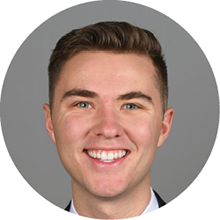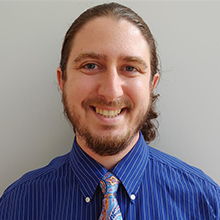Listening Time — 10:11
Listen on Apple Listen on Castbox Listen on Spotify
A brief introduction from the president of the academy.
Corbin Olson, SPT, a second-year student at the University of Mary, interviews Michael Murray, PT, DPT, president of the APTA Aquatics.
Watch the video on the APTA Magazine webpage.
Our Speakers

Corbin Olson is a second-year student physical therapist at the University of Mary and a member of the APTA Student Council.

Michael Murray, PT, DPT, president of the academy and a physical therapist at Duke Health.
The following transcript was created using artificial intelligence and may contain typos, omissions, or other errors.
Olson: My name is Corbin Olson. I'm a second-year student at the University of Mary, and I'm serving on the steering group of the APTA Student Council. I'm joined here by Michael Murray.
Murray: My name is Michael Murray, and I am president of the APTA Academy of Aquatic Physical Therapy. I work at Duke Health in North Carolina. I went to school at Carolina [University of North Carolina at Chapel Hill]. I'm here to talk with students and to talk about what we do with our students in our program.
Olson: Could you start off, Michael, by just telling us a little bit about how you got into your role and what led you there?
Murray: Absolutely. The first time I ever heard about physical therapy was essentially while working at a pool, and there was this lady doing these weird exercises in the water while everyone else was swimming. I said, “What are you doing? She said, “Well, I had surgery.” She had an infection, so she needed two surgeries. And she said, “Yeah, my doctor was good. He cut me open and set me back up. But my PT gave me my life back.” And that really got me into it — I got involved. UNC is really good about pushing their students to go to conferences and seek out opportunities to meet people. So I ran for a student board position. I didn't win, but it was a nice little motivation for me to go and explore other things. Then, at an APTA CSM conference I walked into a board meeting for the Academy of Aquatic Physical Therapy and said, “Hey, I'd like to get involved.” They said, “We're not sure if you can be here, but yeah, come on in. Let's get this working.” I took a negative and turned it into a positive, and I've been involved with the aquatics academy and with the North Carolina chapter since then.
Olson: Sure, that's cool. You just stuck your head out there and made it happen.
Murray: It's one of those things. When you're motivated enough to do something, you'll find the area, and there's always a need; all these components could always use some young eyes on things. I know for us we have our student ambassador, who we rely on a lot. She's on some of our committees, and so we encourage students to get involved in committees whenever they can, because that's a great opportunity to learn the structure, and then once you're out, you can start being on the board because you've already established that connection there.
Olson: Sure. Speaking of students getting involved, what would be the benefit, or why would I consider joining the Aquatics academy?
Murray: Oh, that's a great question. Well, first, we want everyone to be involved with APTA in some shape or form; there's a lot of benefits that you can have as a student that you just can't get if you're not a member. So we encourage people to do that, but we have a really avid student group that we try to advocate for. A lot of times, students come to us and say we have a rotation in aquatics and we have no idea what we're doing. We can provide resources for that, or, especially, think about being a new graduate; maybe you didn't think about aquatics as your first choice and then all of a sudden, you're in a situation. We have educational opportunities. Like I said earlier, our big goal is to make sure that we are engaging the younger generation because we want to make sure that the way we are getting things into the future is going to help the people in that future. And we need young voices on our committees, on our task forces — just a few things to try and get involved in so that we can push things into the future. So that's what we look for.
Olson: Sure, I think that's really solid. The aquatic academy on a day-to-day basis, what sort of work are you doing to support your field?
Murray: A little bit of everything. We have our own journal that we support research in. We have different events. We have our certificate program, which essentially means that if you just want to get some online education and then a three-day full course, you can learn how to be above a basic provider. There isn't a specialization in aquatic therapy; that's something that we've looked into.
We also provide networking tools if you need to develop a program. So let's say you go to a facility and you see that there's a need in your area for aquatics. How can you either develop your own program where you can build a pool if you can find the funding, or how do you partner with hotels, local YMCAs, racquet clubs, or community centers in all these different ways, so that you can provide the necessary things for them? We reach out to different vendors to see if they have opportunities. We used to partner with different groups where we would have funding for different research grants and things like that. My biggest push next is developing a program for students where schools that don't have access to the pools or don't have access to things can come to our learning system, and either the school can let the students have an opportunity to use that by purchasing a small package or have us come and teach the program. We're gearing up for our next phase of developing in-person things for the students because that's an area that we feel is the best way to develop things for the future.
Olson: Yeah, that's fascinating. I think aquatic therapy is kind of an enigma, and so it's fascinating to bring that into every space.
Murray: I joke with people because my background is more orthopedic- and sports-oriented, and we have a lot of people who do pediatrics, and then, obviously, you're going to get a very large geriatric population and the neuro population, as well. We touch all the different components, and we're trying to build those relationships between all of them. In order to do that, we have to show people that I work with the little lady with balance troubles, and the high-level athlete, and everything in between. We are the best generalist physical therapists, in my opinion, because we have to know a little bit about everything, and good aquatic physical therapists think critically about everything. I do want to say, too, that it's not just the physical therapists; it's our PTAs as well. This is one of the professions where PTAs have a strong force and are extremely knowledgeable. I've learned some of the best things from rotations from some of my PTA colleagues, and I think that this is one of the areas where we can really foster that better together type of idea within the aquatics academy, all the different components, all the different states and chapters, all the different payers, and definitely between the PTs and PTAs, and the students, of course.
Olson: Gotcha, yeah, that's fascinating. You provide a lot of awesome opportunities and made me excited about the Academy of Aquatic Physical Therapy. If I'm just a second-year student, or any student interested in the section, how would I get involved in that?
Murray: Oh, that's great. You can always reach out to our academy itself. It's admin@aquaticpt.org. We have our student ambassador, Erica Block, who’s a Duke student, and she's fantastic. We've tasked her with engaging other people as well. It's one of those things where we're reaching out to the student population, and the student population is hopefully reaching back to us so that we can form a mutual relationship. But the biggest thing I learned when I was young from somebody who was a student board president was to go and talk to the presenters, go and talk to the leaders of these organizations — they're just physical therapists, they're just people, and they love to talk to you anyway. Most of the important things happen in those conversations. But that's where things happen, where you build those relationships. Some of the best presentations I've had were just by talking to people and saying, "Wow, you're interested in this? Oh, that's cool. Wait, we should work together on this type of thing." And that started as a student, and now it just blossoms because those students grow up with you the whole time, so it’s great opportunities.
Olson: Well, thank you very much for your time and everything you know. Is there anything else that I'm missing?
Murray: No, I think the biggest thing is that when we talk about the better together thing, it's important that we talk about the students, we talk about PTAs, we talk about PTs all working together. My biggest thing is that I want to keep the students involved, and if you get them involved early and do the early-career dues discount, that you stay with APTA, you stay with education, you come to APTA CSM, and you get the best networking you can ever have. I work with people who are professional PTs for professional sports teams and PTs who are running education programs. Things that you see that people get interested in get me interested in things and build up my knowledge, so the more we can share that knowledge together, the better PTs and PTAs we are all together.
Olson: I think it's a great point. Even as a student being here, everything is just growing, absolutely. And your interest and excitement — that's a great way to do it.
Murray: You get bogged down with school sometimes. The fact that you can come here and just understand that you're going to know your knowledge, you're not going to know everything; some days you know everything, and some days you feel like the worst PT in the world and you don't know anything. And the patients will try you on that. But this is the opportunity to build up those relationships with people. I know there are a lot of PTs in aquatics that focus on lymphedema. That is not necessarily my strong point. I know now who I can go to in the aquatics world, in the oncology world, or even in something random like pelvic health. We have a great relationship with the pelvic health professionals because there's a lot of core stability that goes on with the pool. So you start building up these little things that you never would have thought of, building up these relationships, and this is where the magic happens. And then just being able to continue that magic when everybody goes home and they're away from summer camp again.
Olson: For sure. Well, thank you again very much, and I look forward to connecting in the future.
Murray: Yeah, great. Have a good one.